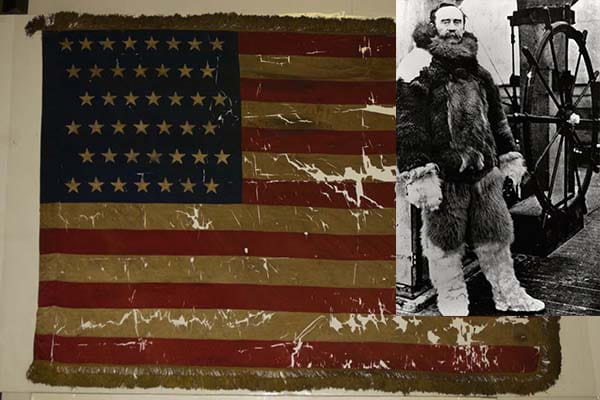Hidden Treasures: The 43-Star Arctic Expedition Flag at the Academy of Natural Sciences

- Ribbon-Cutting Ceremony Marks Official Unveiling of Drexel Station at 30th Street
- Express Your Thoughts About Climate Change in the Anthems for the Anthropocene Contest
- 40 Years Ago, Drexel Made Computer — and Apple — History
- Drexel Helps Promote Philadelphia as a Premier Destination for Global Education

The Academy of Natural Sciences of Drexel University boasts scores of specimens from the biological world. But one of its most unusual artifacts is entirely man-made.
The roughly 4-by-5-foot American flag on display on the Academy’s second floor, outside the library, is a curiosity because of its number of stars — 43, reflecting the addition of the state of Idaho in July of 1890 but not of Wyoming, admitted to the Union just a week later — and its nearly square shape. But what makes it even more remarkable is the story behind it.
It is the flag carried by Robert E. Peary on his first major Arctic expedition, which was financed by the Academy and its members, in 1891-92. Peary would ultimately claim to be the first person to reach the North Pole in 1909 (though some historians have raised doubts that he actually made it there).
Peary craved fame, admitting as much in a letter to his mother in 1887 as recorded in "A Glorious Enterprise," a history of the Academy co-authored by Senior Fellow Robert Peck. Peary certainly achieved that goal, Peck said, whether or not he truly reached the North Pole.
“In his day, Peary was as well-known as Charles Lindbergh or Neil Armstrong would become later in the century,” said Peck, the Academy’s house historian. "He was a national hero of monumental proportion."
Peary’s lust for the limelight was likely his chief motivation for contacting the Academy in 1890 to ask for funding for an expedition to the Arctic, though his pitch to collect biological specimens during his travels appealed to the Academy and its members. “He was a very ambitious guy,” Peck said, “and he knew how to work the system.”
So the Academy invited Peary, then an officer at the Philadelphia Navy Yard, to present a proposal, and eventually the institution and its members contributed the funding for his trip.
It was tradition on such expeditions to carry a national flag for the purpose of “claiming” newly discovered territories. And at a lavish sendoff reception shortly before the departure, the Academy presented Peary with a 43-star silk version of the Stars and Stripes.
Peary ultimately did hoist the flag on the northern coast of Greenland, despite breaking his leg in an accident on his way north, an injury that prompted the Academy to mount a second expedition for the purpose of rescuing him. Along the way, the expedition did collect a wide variety of new specimens for the Academy: polar bears, musk ox, seals, birds and plants.
With an Arctic collection already in hand, the Academy declined to fund Peary’s further conquests. But now that he’d made a name for himself, he was able to attract funding from wealthy patrons in New York. And Peary would later acknowledge that it was on his Academy-financed trip when he first learned how to travel in the harsh Arctic, and to work with the native Inuit population.
“He felt a warm spot for the Academy and for Philadelphia for having helped him get his career in Arctic exploration off the ground,” Peck said.
Peary’s flag, its star count already outdated, returned with him to Philadelphia in 1892, where the Academy threw another festive party to celebrate his achievements and welcome him home. He presented the flag to the Academy and there it remained for over a century. Because of its frequent display, by the 2000s, the silk flag was badly deteriorated, Peck said.
In 2007, the Academy raised funds to have it restored, and soon after it took its current place on the wall outside the library. Today, it’s one of two flags from Peary’s expeditions still in existence. (The other, a flag from his 1909 North Pole trip, is owned by the National Geographic Society.)
“It went from being close to a pile of confetti, with individual pieces falling away, to the beautifully conserved flag you see on display today,” said Peck.
During his northern travels, Peary named a glacier Academy Glacier, in the honor of his benefactor. Peck likes to call this a “frozen asset” of the Academy’s. And the Academy has maintained a presence in the Arctic: Vice President Ted Daeschler, a member of Drexel's BEES faculty, is currently conducting paleontological research on an island not far from the North Pole. In 2009, a contingent flew an Academy flag at the North Pole to mark the 100th anniversary of Peary’s (claimed) conquest.
— This article is based, in part, on “’I Must Have Fame’: Robert Peary Explores the Arctic,” Chapter 9 in “A Glorious Enterprise: The Academy of Natural Sciences of Philadelphia and the Making of American Science” by Robert McCracken Peck and Patricia Tyson Stroud.
In This Article
Drexel News is produced by
University Marketing and Communications.
